Screen printed subversions
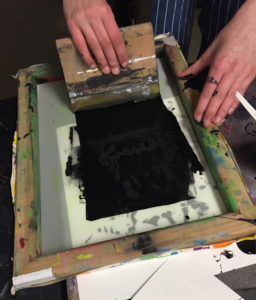
Applying Ink to the Screen
In this last solo workshop using screen printing with text and image, I started with a
warm up on idioms, giving the definition, showing some examples and explaining that I would
like them to twist them into another meaning, in a way that could be absurd, political,
environmental or some other personal concern they had. Since this group is composed of
thinkers, I gave them a book and a deck of cards to check out so they could understand better
what I wanted them to do. I also passed out a handout on idioms about climate change from the
New Yorker. Then, they wrote down three idioms in their sketchbooks and twisted these into
another meaning. After that, I showed slides about artists such as Barbara Kruger who makes appropriation art using image and text. During the demonstration, I explained the process of screen printing step-by-step and put up a slide with the steps. After the demo, they made thumbnails about one or two of their idioms and then went to work drawing on a larger piece of paper, tracing onto the film with sharpie and then cutting out the areas that that were going to be inked for printing. The launch questions included the following: What is subversion and how do these artists in the slides use it in their art? What are their methods? How can you subvert idioms to create art?
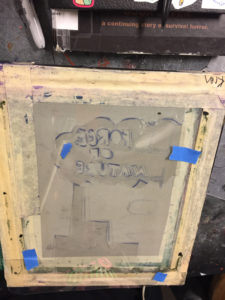
Taping the Clear Film to the Screen
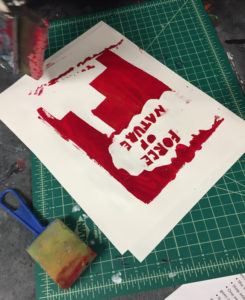
Test Print on Paper
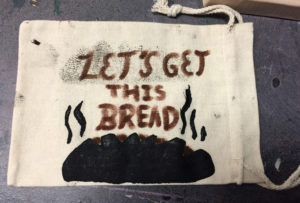
Let’s Get This Bread
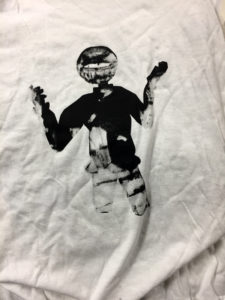
A Character Print
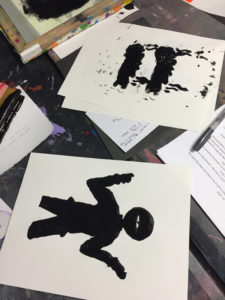
Test Prints

Student Print of Twist on Idioms for Climate Change
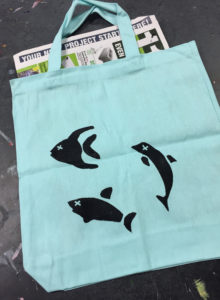
Bag in Process
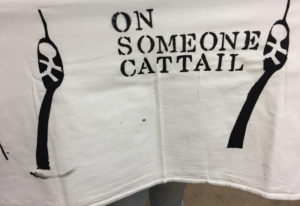
A Print on the Spin of the Idiom: Riding on Someone’s Coat Tail.
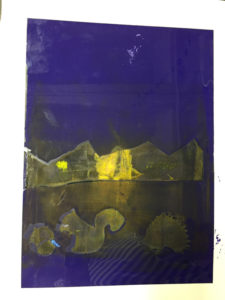
Screen with Ink
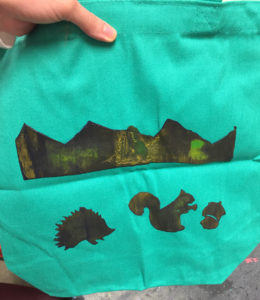
Print of Acid Rain on a Bag
_____________________________________________________________________________
Name: Tessa Sutton
Grade Level: 7-8
Time needed: 90 minutes
Class Size: 20-25
Overall Goal: The goal of this activity is to allow students to explore screen printing techniques and materials through the use of subverting and playing with idiomatic phrases from the English language, connecting them to their personal interests.
Problem: How can you subvert the meanings of pre-existing idioms and create a new play on words through experimenting with illustration in screen printing? How can you play with these meanings while connecting them to your environmental, social and political interests?
Big Ideas: Storytelling, Self-Expression, Subversion, Wordplay, Imagination, Play, Humor
Description & Purpose: Students will explore screen printing on T-shirts, cotton bags or paper of their choice through twisting idioms into personal concerns that could range from the serious to the absurd. By altering these phrases, they make the viewer stop and take a second look, coming in closer to the subject matter. The purpose is to make students not only question the language that is taken for granted to be reinvented, but to see the space between language and text that artists like Barbara Kruger and others have used widely, as well as communicate their personal concerns.
Importance: Subversion means altering something existing and twisting the meaning into another form. Artists have used wordplay and subversion since the Dadaists recombined language in their art. Using idioms, which are already abstracted from the English language encourages students to play with already puzzling language. Subversion involves a change in expectation experienced by the artist in their everyday lives, or teasing the audience into thinking they understand one aspect, but the artist is talking about another. This concept can be applied aesthetically, conceptually and personally in a work of art. By experimenting with screen printing techniques, the student can explore applying this idea as their subconscious comes into play. Olivia Gude relates how students should use their personal interests and experiences when creating art as well as play with deconstructing culture.
Art Concepts/Technical Skills: Students can explore the connection between image and text in their pieces through illustration and visual storytelling with minimalistic images using screen printing stencils. They will also investigate how artists have used subversion in their work and how they could apply this to their own.
SPECIAL PRE-INSTRUCTION PREPARATIONS
- Teacher will need to collect enough printing screens for students to use individually as well as screen printing film.
Common Errors or Misunderstandings
- Students may not understand negative space and that what you remove from the screen film will be the part with the ink that comes through.
- Students might not comprehend how to make layers by covering parts up on the screen.
- Students may not know what idioms are.
- Teacher will explain to students that the negative space on the final product will not have ink and the places they remove with the exact-o knife will have the ink come through. They may choose to make the negative space ink-filled but only after understanding it.
- Teacher can show negative space and where the ink will come through in the demonstration.
- Teacher will explain in demonstration how certain areas can be covered with duct tape if they want to work in layers, allowing the paint to dry between each one.
- Instructor to explain the meaning of idioms in the slides.
National Standards
- CREATING: Generate and conceptualize artistic ideas and work, Anchor standard 1.
Enduring Understanding: Creativity and innovative thinking are essential life skills that can be developed. Artists and designers shape artistic investigations, following or breaking with traditions in pursuit of creative art-making goals. - PRESENTING: Convey meaning through the presentation of artistic work, Anchor standard 6.
Enduring Understanding: Objects, artifacts, and artworks collected, preserved, or presented either by artists, museums, or other venues communicate meaning and a record of social, cultural, and political experiences resulting in the cultivating or appreciation and understanding. - CONNECTING: Synthesize and relate knowledge and personal experiences to make art, Anchor standard 10.
Enduring Understanding: Through art-making, people make meaning by investigating and developing awareness of perceptions, knowledge and experiences. - RESPONDING: Interpret intent and meaning in artistic work, Anchor Standard 8.
Enduring Understanding: People gain insights into meanings of artworks by engaging in the process of art criticism.
Learning Objectives
- TLW observe and discuss the artists presented in the slides in a group in order to analyze how art can show subversion through graphic elements. Anchor standard 8.
- TLW design and create at least one screen print of their twisted idiom on a T-shirt, bag or bandanna through first brainstorming at least three thumbnail sketches from the warm up of three twisted idioms based on their personal concerns about environmental, social and political issues. Anchor standard 1 & Anchor standard 10.
- TLW place their work on the tables for a gallery walk for the students to observe and discuss their processes by interviewing a partner and recording on a note card. Anchor Standard 6.
teacher Materials
- Teacher example of print
- Exact-o knives
- Duct tape paper for “islands” needed to fill in spaces not attached to other parts of stencil
- Stencil film
- Duct tape
- Computer with any cables needed
- Monitor
- PowerPoint
- Process / technique demonstration materials: squeegee, screen at least 8 x 10 in., water based screen printing ink, plastic spoons, paper to print on.
Student Materials
- Paper (can be a sketchbook)
- Heavy paper for test print
- Cardboard
- Glue
- Masking & duct tape
- Scissors & exact-o knives
- Cutting mat
- Pencils
- Screen frame
- Fabric pens
- T-shirts, bags and bandannas for each student (at least one of each per person)
- Duct tape paper sheets: 8.5 x 11 in.
- Squeegee
- Paper plates
- Plastic spoons
- Stencil film
- Stencil letters of a small size (in case they want to do writing on their pieces)
- Note cards of any size
- Sharpies of various colors
Artists in context: Key artists
Barbara Kruger, Max Ernst, Hank Willis Thomas, Marcel Duchamp, Steve Gianakas, Kurt Schwitters and Theo van Doesburg
Key artworks
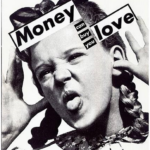
Barbara Kruger, Untitled (Money Can Buy You Love), Collage, 7 x 8 in., 1985

Barbara Kruger, Untitled (We Don’t Need Another Hero.), Photo screen print on vinyl, 100 x 209 x 2 in., 1987.
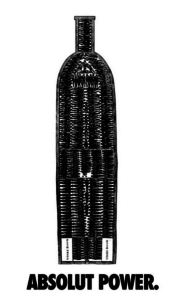
Hank Willis Thomas, Absolut Power, Inkjet print on paper, 40 x 28 in., 2003.

Theo Theo van Doesburg and Kurt Schwitters, Small Dada Evening, Lithograph, 11.8 x 11.8 in.,1922.

Max Ernst, The Chinese Nightengale, Ink on paper mounted on board, 5 x 3.5 in., 1920.
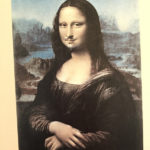
Marcel Duchamp, L.H.O.O.Q., Pencil on reproduction, 25.5 x 19 in., 1930.
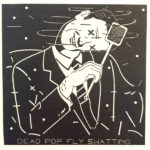
Steve Gianakos, Dead Pop Fly Swatting, Acrylic on canvas, 30 x 30 in., 1981.
Teacher Example
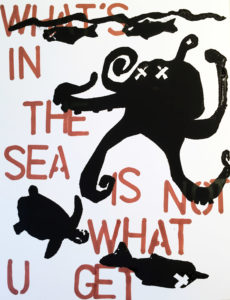
Stop Global Warming. Acrylic screen print on paper, 8.5 x 11 in., 2019.
Key Critical questions
- What is subversion?
- What are the different ways these artists subvert images with text? How is text used in each to convey meaning?
- How could you use the methods of the Dadaists in your piece? What are these methods?
- How do you see that they use appropriation as a way to work with subversion? Why do you think they use this?
Vocabulary and Language Acquisition
Discipline Specific (Syntax)
Space: is the area between and around objects. The space around objects is often called negative space; negative space has shape. Space can also refer to the feeling of depth. Real space is three-dimensional; in visual art, when we create the feeling or illusion of depth, we call it space.
Negative Space: the space around the subject of the work of art, such as shapes or forms.
Contrast: a principle of art that refers to the arrangement of opposite elements (light vs. dark colors, rough vs. smooth textures, large vs. small shapes, etc.) in a piece, so as to create visual interest.
Emphasis: is the part of the design that catches the viewer’s attention. Usually the artist will make one area stand out by contrasting it with other areas. The area could be different in size, color, texture, shape, etc.
Graphic Design: the art or profession of using design elements (such as typography and images) to convey information or create an effect.
Shape: the visible makeup characteristic of a particular item or kind of item.
Unity: a combination or ordering of parts in a literary or artistic production that constitutes a whole or promotes an undivided total effect.
Islands (in screen printing): Refers to the parts of an image that are not connected to other parts of the image, where you do not want ink to go through onto your print.
Appropriation: in art and art history refers to the practice of artists using pre-existing objects or images in their art with little transformation of the original.
Academic
Deception: the act of causing someone to accept as true or valid what is false or invalid.
Idioms: an expression in the usage of a language that is peculiar to itself either grammatically or in having a meaning that cannot be derived from the conjoined meanings of its elements.
Wordplay: playful use of words; verbal wit.
Subversion: to pervert or corrupt by an undermining of morals, allegiance, or faith.
| Language Functions | analyze, compare/contrast, critique, describe, interpret, question, etc. | |||
| Language Modes | Reading | Writing | Listening | Speaking |
|
|
|
|
|
ACCOMMODATIONS FOR SPECIFIC DIVERSE LEARNERS |
| Enrichment and Extensions |
|
| Activity for Early Finishers |
|
OBJECTIVE-DRIVEN ASSESSMENTSDescribe the tools/procedures that will be used in this unit to monitor students’ learning of the lesson objectives. Attach/paste a copy of the assessment and evaluation criteria/rubric at the end of the lesson where the assessment will take place. |
|||||
| Lesson # | Objective # (s) | Informal or Formal? | Description of Assessment | Modifications to Accommodate All Students | Evaluation Criteria: What evidence of student learning related to the learning objectives and central focus does this assessment provide? |
|
|
TLW observe and discuss the artists presented in the slides in a group in order to analyze how art can show subversion through graphic elements, Anchor standard 8. | Informal
|
TLW engage in a discussion with peers and teacher about how the artists shown in the slides play with text and image through subversion in their art. | Students can write on a paper if they do not feel comfortable sharing in front of the group, or speak with a partner nearby. | Students verbally express and give immediate feedback on the quality and depth of their answers regarding understanding how subversion is used in the art shown. By giving examples of this, it shows the depth of students’ understanding of the idea of subversion, how it is used in art and how they could apply these to their own work. |
| TLW brainstorm and draw at least three thumbnail sketches from the warm up of three twisted idioms based on their personal concerns about environmental, social and political issues. Anchor standard 1. | Informal | Teacher will walk around the room and ask questions to check students’ understanding of the activity verbally. Teacher will check that thumbnails have been completed and discuss which one the student will use before proceeding to screens.
|
Student can make one thumbnail sketch instead of three. Teacher or peer can help with sketching, if needed. | Students demonstrate skill in generating twisted idioms through wordplay and connecting them to personal concerns in the medium of screen printing with a print artifact. | |
| TLW design and create at least one screen print of their twisted idiom on a T-shirt, bag or bandanna based on their preliminary sketch of choice. Anchor standard 10. | Informal) | Teacher will observe that students are making the screen prints correctly and ask questions to check for understanding. | Teacher or peer can assist in screen printing and cutting process through verbal direction by student. | This shows that students are able to reflect on their sketches and choose their most successful one as well as complete the technical aspects of screen printing. | |
REFERENCES |
||||||
| Barbara Kruger, feminist art. (n.d.). Art history archive. Retrieved from http://www.arthistoryarchive.com/arthistory/feminist/Barbara-Kruger.html.
Blythe, S., & Powers, E. (2006). Looking at Dada. New York: NY: Museum of Modern Art. Gude, O. (2007, January). Principles of possibility: Considerations for a 21st-century art & culture curriculum. Art Education, 6-17. Hank Willis Tomas, “Absolut power” and “Afro-American express.” (2014). Black Atlantic, Duke University. Retrieved from Kruger, B. Untitled (we don’t need another hero). (1987). Whitney Museum of Art. Retrieved from https://whitney.org/collection/works/34103. Terban, M. (1996). Scholastic dictionary of idioms. New York, NY: Scholastic, Inc. Tucker, M. (1981). Not just for laughs: The art of subversion. New York, NY: New Museum. Word definitions. (2019). Merriam-Webster Dictionary. Retrieved from https://www.merriam-webster.com/dictionary. |
Launch |
Instruction Methods |
|
Warm Up: (5 min.) |
|
|
| Instruction | Instruction Methods | |
| Procedure Lesson Introduction: (10 min.) 4. Instructor will present the problem generally that they will be making at least one screen print, on a T-shirt, cotton bag or bandanna, of a twisted idioms that connects with a personal interest of some kind. Teacher also explains they will be making three thumbnail sketches before from the warm up idioms and clarifying with the instructor before proceeding. (2 min.) 5. Slide presentation of short history of subversion using images and text. (5 min.) 6. Teacher presents the technique of screen printing through a live demonstration and shows previously made examples, making sure the proper way to use an exact-o blade on their cutting mat, noting hand placement away from blade. (3 min.) Create: (65 min.) Closure: (9 min.) Clean up: (6 min.) Structured Practice and Application
Assessment:
|
|
|
| Closure | Instruction Methods | |
|
Lesson Closure: See summative assessment. After the interviewed students place note cards on table near their work, the students will walk around once more. |
|
|